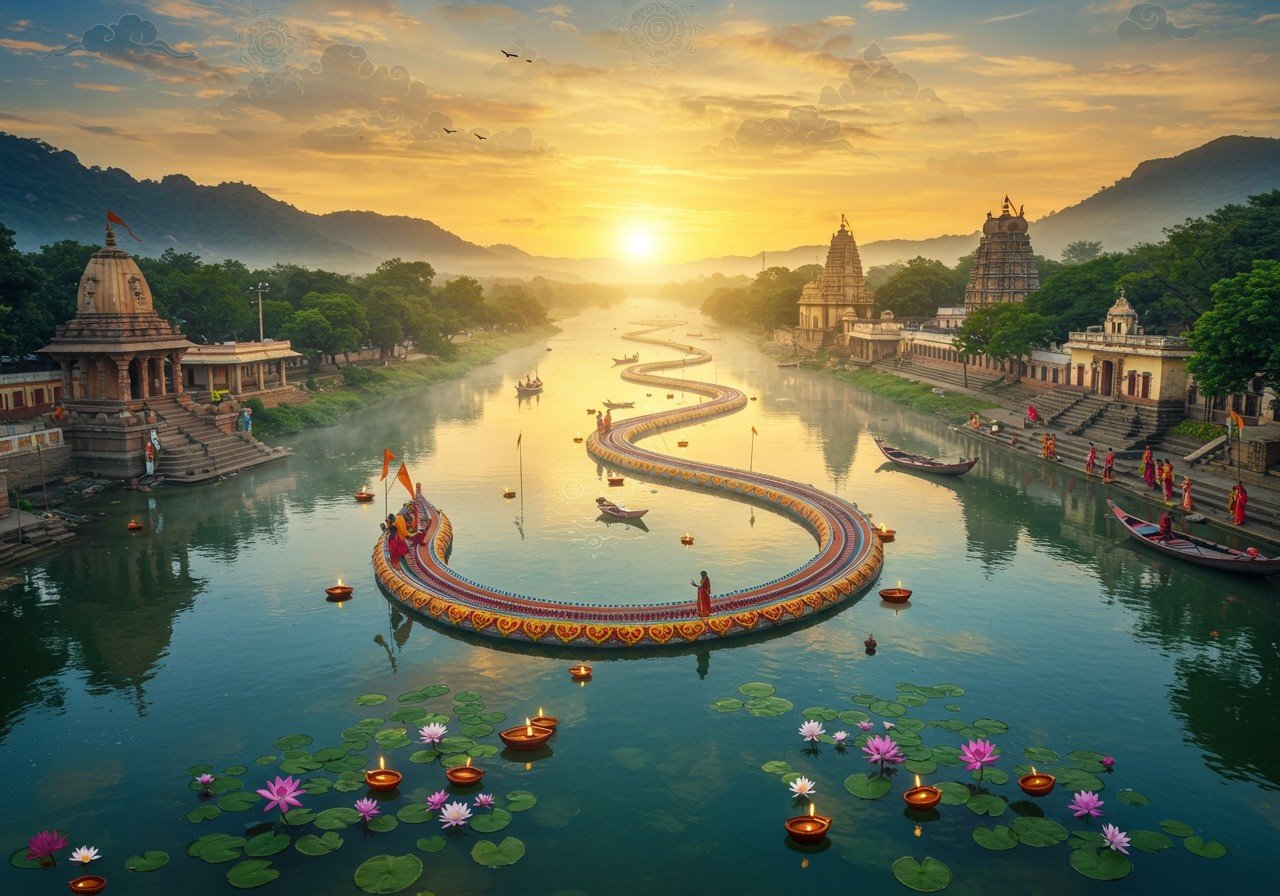
The Kapila River, also known as Kabini or Kabani, gracefully flows through southern India, holding immense historical and cultural significance. Its journey begins in the Western Ghats, meandering through Karnataka and impacting the lives and traditions of the communities along its banks. This blog delves into the river’s origin, course, and significance in shaping local communities and traditions. For those who appreciate cultural heritage and prefer to buy authentic ritual items online, this exploration will be particularly insightful.
Where is the Kapila River Located?
The Kapila River is primarily situated in Karnataka, southern India. It originates in the Wayanad district of Kerala, specifically from the Brahmagiri range within the Western Ghats. As it flows, it becomes a crucial water source for the towns and villages along its banks. The river’s course significantly influences agricultural practices, supporting the cultivation of diverse crops. Moreover, it plays a vital role in sustaining local biodiversity and enhancing the ecological balance of its surroundings.
Kapila River Map
A map of the Kapila River clearly depicts its journey from its origin to its confluence. It highlights key towns and geographical features along its path, providing a comprehensive understanding of how different communities are connected. Furthermore, the map marks important tributaries that feed into the river, showcasing their contribution to maintaining its flow. Over time, historical shifts in the river’s course have significantly affected regional development, influencing settlement patterns and transportation routes.
Cultural Significance of the Kapila River
The Kapila River is deeply intertwined with the local culture and traditions. It is celebrated in folklore and mythological tales, underscoring its spiritual value. Various religious ceremonies and rituals are centered around the river, establishing it as a central element of community life. Festivals celebrated near the river serve as occasions for cultural expression and unity. Moreover, the river inspires traditional arts, crafts, music, and dance forms, reflecting its profound impact on regional identity. Temples and historical sites located along the river offer valuable insights into its historical significance. For devotees seeking authentic puja items for these rituals, consider exploring the offerings at Poojn.in.
Navigating the Kapila River
Navigating the Kapila River has been essential for trade and transportation for centuries. It connects various towns and markets, facilitating the exchange of goods and ideas. Traditional boats and ferries are still used, preserving age-old navigation practices. However, navigating the river presents unique challenges due to seasonal changes and varying weather conditions. Modern developments have significantly improved connectivity, supporting economic growth and promoting tourism. Balancing ecological preservation with development remains crucial to maintaining harmony between nature and progress. You can find essential puja items for rituals related to the Kapila River on Poojn.in.
Geographical Significance of the Kapila River
The Kapila River, also known as Kabini or Kabani, originates in Kerala’s Wayanad district. Its waters begin at the confluence of the Panamaram and Mananthavady rivers. Flowing eastward, it enters Karnataka and eventually merges with the Kaveri River at Tirumakudalu Narasipura. The Kaveri River then plays a crucial role in irrigating Tamil Nadu and providing drinking water, before ultimately emptying into the Bay of Bengal. It supports diverse ecosystems and forms a large reservoir near Sargur, situated between the Bandipur and Nagarhole National Parks. This area is teeming with wildlife, as the river meanders through the Wayanad Wildlife Sanctuary and the Nilgiri Biosphere Reserve, a UNESCO World Heritage Site.
Historical Significance of the Kapila River
The Kapila River boasts a rich history, deeply influencing the region’s cultural and economic development. It has long served as a vital source for irrigation and transportation, fostering growth and progress. The river has witnessed the rule of several dynasties, including the Kadambas, Gangas, and Hoysalas. These rulers left their mark by constructing temples and forts along the riverbanks. During the Vijayanagara Empire, the area surrounding the Kapila River flourished. Historically, it also served as prime hunting grounds, attracting visitors from across the globe. In the 1970s, recognizing its ecological importance, authorities designated it a wildlife sanctuary to protect its rich biodiversity. Devotees can find a wide selection of ritual items for ceremonies related to the Kapila River at Poojn.in.
Cultural and Religious Significance of the Kapila River
The river holds profound cultural and religious significance. It is believed that sage Kapila meditated on its banks, giving the river its name. For the numerous tribal communities residing nearby, the river has served as a lifeline for generations. In Hindu mythology, the Kapila River is associated with purification rituals, believed to cleanse individuals of sins, particularly those related to alcohol consumption. In Somnath, Gujarat, the Kapila River converges with the Hiran and Saraswati rivers at the Triveni Sangam, a sacred confluence. A holy dip at this confluence is believed to purify one’s soul. For those seeking to perform these rituals with authentic items, Poojn.in offers a wide range of puja samagri and other religious goods.
Modern Significance of the Kapila River
Today, the Kapila River continues to be a vital source of water for irrigation and drinking. The Kabini Dam, constructed in 1974, supplies water to countless villages and major cities like Mysuru and Bengaluru. The Kabini area is also renowned for its thriving wildlife tourism, drawing nature enthusiasts and adventure seekers. The reservoir, teeming with biodiversity, is a haven for wildlife aficionados. The river’s passage through essential wildlife sanctuaries and national parks makes it a cherished destination for those eager to explore India’s natural beauty. The Kapila River remains a beacon of life, culture, and tradition in southern India. Find all your puja needs for rituals by the Kapila River at Poojn.in. We offer a wide variety of authentic puja items, delivered right to your doorstep.
Poojn.in: Supporting Your Kapila River Rituals
Poojn.in is proud to offer a wide range of puja items and materials specifically curated for rituals performed along the sacred Kapila River. Our online store provides:
- Complete Puja Samagri Kits: These kits are thoughtfully assembled to include everything you need for Kapila River rituals, ensuring a convenient and authentic experience. We understand the importance of having all the necessary items readily available, and our kits are designed to simplify your preparations.
- Pure Copper and Brass Vessels: We offer a selection of high-quality copper and brass vessels ideal for water offerings and other ritualistic uses. These vessels are crafted with traditional methods to ensure purity and durability.
- Traditional Dhoop, Agarbatti, and Camphor: Enhance your aarti ceremonies with our selection of traditional dhoop, agarbatti, and camphor. We source these items from trusted suppliers, guaranteeing their authenticity and quality. Create a sacred atmosphere with these aromatic offerings.
- Fresh Flowers and Garlands: Adorn your rituals with fresh flowers and garlands, adding a touch of natural beauty to your offerings. We provide a variety of floral options to suit your preferences, ensuring a vibrant and fragrant experience.
- Eco-Friendly Items: We are committed to respecting the sanctity of the Kapila River and offer eco-friendly options for your puja needs. Choose from our selection of sustainable products to minimize your environmental impact while maintaining the authenticity of your rituals.
We deliver these authentic puja items across India, making it convenient for devotees to obtain everything they need for their Kapila River rituals. Our products are sourced from verified vendors who uphold traditional quality standards. Visit Poojn.in or download our mobile app to browse our complete selection of ritual items. We offer secure packaging and timely delivery to ensure your puja materials arrive in perfect condition. For bulk orders or custom puja kits, contact our customer service team through the website or app. Poojn.in is dedicated to supporting you in maintaining sacred traditions with convenience and authenticity. You can find copper vessels suitable for rituals here: https://www.poojn.in/product/16363/pure-copper-debi-ghat-6-no-devi-ghot-10-height-devi-ghat-made-of-thick-copper-sheet-heavy-weight-pure-copper-noggin and https://www.poojn.in/product/15408/pure-copper-debi-ghat-4-no-devi-ghot-9-height-devi-ghat-made-of-thick-copper-sheet-heavy-weight-pure-copper-noggin.
The Enduring Legacy of the Kapila River
The Kapila River stands as a testament to the enduring connection between nature, culture, and tradition in southern India. Its journey from the serene hills of Wayanad to its confluence with the mighty Kaveri is a path rich with ecological splendor and historical depth. The river nurtures life, supports biodiversity, and sustains ancient traditions with its sacred waters. For generations, the Kapila River has been more than just a waterway; it is a source of life, spirituality, and community. It weaves through the fabric of history and modernity, linking the past with the present. As it continues to flow, the Kapila River invites us to cherish and preserve its legacy—a legacy that embodies the harmonious balance between humanity and the natural world. Learn more about other sacred sites in India on our blog: Kapila Theertham and Kodandarama Temples of India.
Kapila Theertham Tirupati’s Sacred Waterfall Temple provides details about the temple near the river. For travel information, see Kapila Theertham Travel Guide.


